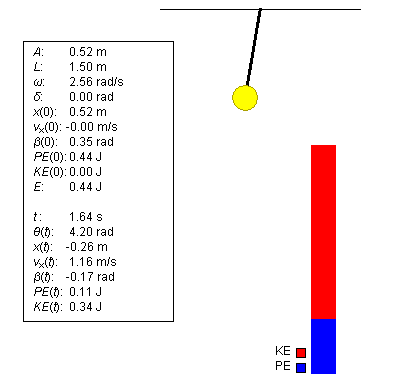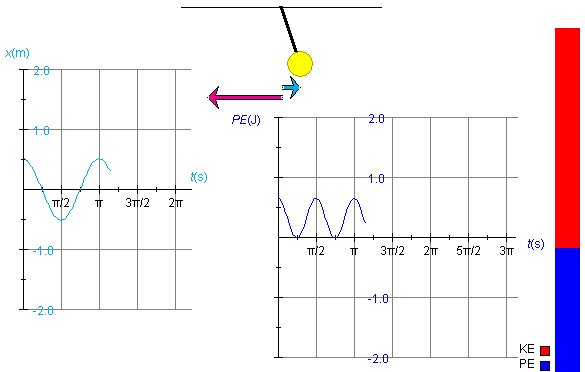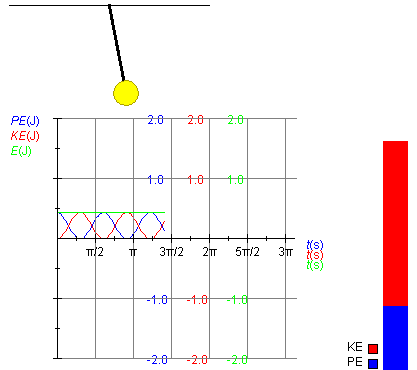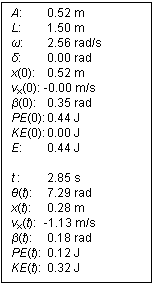
This document shows you how to use this applet in a step-by-step manner. You should have the applet open; toggle back and forth between the ShowMe file and the applet as you work through these instructions.
Exercise 1
Set the amplitude to 0.52 m, and keep the mass, length, and magnitude of gravitational acceleration at their default values of 0.50 kg, 1.50 m, and 9.8 m/s2, respectively. Display the Data box.
Start the motion from its default position (which has the pendulum bob in its most deflected position to the right), such that the phase Δ is equal to 0. Play the motion, and Pause it at or near t = 0.70 s. The spring, energy bar, and Data box should look like that shown in Figure 1:

Figure 1
The ratio of the kinetic energy portion (red) and potential energy portion (blue) of the energy bar should correspond to the ratio of these energies as displayed in the Data box. In the case shown in Figure 1, this ratio has the value KE/PE = 0.34/0.11, which is close to 3/1.
Exercise 2
Continuing from Exercise 1, click "Rewind". The pendulum should be back in its right-most position. Drag the pendulum bob from the right to the left of its range of motion, and observe the variation in the potential energy.
You should find that the potential energy goes from its maximum value when the pendulum is at the far right, to its minimum value when the pendulum is at its equilibrium position, back to its maximum value when the pendulum is at the far left.
Exercise 1
Reset the applet. Start the motion at t = 0 with the pendulum in its right-most (default) position. Display both the position vs. time and potential energy vs. time graphs and arrange them as shown in Figure 2. Set the amplitude to 0.52 m and the length to 1.00 m, and keep the mass at 0.50 kg and the magnitude of the acceleration due to gravity at 9.8 m/s2.
Play the motion until the oscillation has gone a little bit beyond one complete cycle, so that the pendulum starts moving left again. The two graphs should look similar to that shown in Figure 2. Ignore the position and velocity vectors for the time being.
To display the graphs, click on the Graph control button.

Figure 2
x is the horizontal coordinate of the centre of the pendulum bob. The x-axis increases to the right, with x = 0 at the pendulum's equilibrium position. The potential energy PE is very nearly proportional to x2 when the amplitude is not too large. To the extent that the motion of a simple pendulum approximates simple harmonic motion, it is true that
PE = (1/2)(mg/L)x2
Therefore, as x decreases, reaches 0, and decreases further to negative values, PE decreases, reaches 0, and increases again to positive values. As a result, the frequency of oscillations of the potential energy PE is twice that of the frequency of the displacement x.
Observe that on the horizontal axis of the graphs, the time t is plotted in seconds (s). Don't be mislead by the unusual divisions labeled π/2, π, etc. These are in seconds, not in radians. Thus, the point where the x vs. t graph crosses the t-axis for the first time is at a time close to t = π/4 s. The reason for dividing the time axis in this way is that the expression for the period T of the oscillating spring is
T = 2π (L/g)
(L/g)
The presence of π in this expression makes it natural to divide the time axis into segments that are multiples (or fractions) of π.
Also observe that the maximum x-value in the x vs. t graph is equal to the amplitude, A = 0.52 m, and that the maximum value of PE is related to that of A according to the expression for PE given above:
PE = (1/2)mg/LA2 = (1/2)×0.50×9.8/1.00×0.522 = 0.66 J
Exercise 2
Continuing from Exercise 1, hide the position vs. time graph and display the kinetic energy vs. time graph instead, in addition to the potential energy vs. time graph. Arrange the graphs so that they don't overlap.
Click "Rewind" to put the weight back to its top position, and click "Reset" in the Graph panel (NOT the main "Reset" control button) to clear the two graphs. Then Play the motion again through a bit more than one cycle.
You should again obtain the PE vs. t graph shown in Figure 2 above. The KE vs. t should look like the "inverse" of the PE vs. t graph, i.e. KE should be increasing when PE is decreasing, and vice versa.
Exercise 3
Continuing from Exercise 2, check the "pos" and "vel 1" checkboxes in the Control Panel to display the position and velocity vectors of the oscillating weight in blue and magenta, respectively. These vectors are shown in Figure 2.
The potential energy is proportional to the square of the length of the position vector and the kinetic energy is proportional to the square of the length of the velocity vector.
Select the Zoom control button. The velocity vector and the two graphs should decrease by a factor of 2 in length or height and the energy bar should decrease by a factor of 4. Then deselect the control button again to restore the original heights.
Exercise 4
Continuing from Exercise 3, click "Rewind", and reset the two graphs in the Graph panel. Change the mass from m = 0.50 kg to m = 1.00 kg. Ignore the fact that the energy bar will probably exceed the height of your applet window in this case. Play the motion again through a bit more than one cycle.
You should be able to observe that the kinetic and potential energy graphs have doubled in height compared to those in Exercise 3, but that the velocity vector has the same amplitude as before.
According to the equation quoted earlier, the reason for the doubling of the amplitude of the PE graph is that PE is proportional to the mass. Since the total mechanical energy E is equal to the potential energy at the start when KE = 0, the total energy is doubled as well when the mass is doubled. And so is the kinetic energy, because KE = E - PE.
If both KE and m are doubled, the speed must stay unchanged, in accordance with the equation
KE = (m/2)v2
Exercise 5
Reset the applet, and change the value of the amplitude from 0.17 m to 0.52 m. Display all three energy graphs (potential, kinetic, and mechanical energy). Keep all three graphs superimposed on each other in one place.
Play the motion long enough to cover a little more than one cycle. You should obtain graphs similar to those shown in Figure 3:

Figure 3
The three graphs may have to be moved slightly so that they do not overlap with the energy bar. To move them, check the movability icon for all three graphs in the Graph panel and then drag them - they will move together as one unit.
Observe that the green graph for the mechanical energy E is a straight horizontal line at the tops of the KE and PE graphs. Also, observe that the graphs have gone through a bit more than two cycles, while the motion itself has gone through a bit more than one cycle.
The applet lets you vary the values of the four quantities A, L, m, and g. (You would have to go to the moon or to another planet to be able to study pendulum motion under conditions of different g in reality.)
In the following exercises you will be asked to examine the dependence of the potential energy on these four variables. More specifically, you will learn that the potential energy is a function of time during the pendulum's oscillation and takes on its maximum value both at the far right and far left positions of the pendulum bob. The exercises are about this maximum value and finding out whether it depends on A, L, m, and g. In this connection, remember that the expression for the potential energy is
PE = (1/2)(mg/L)x2
Exercise 1
Reset the applet, and then display the Data box by selecting the Data control button.
Make a drawing of the height of the potential energy bar and record the value of the potential energy as given in the Data box.
Change the Amplitude slider from A = 0.17 m to A = 0.52 m. Again, draw the potential energy column next to the one already drawn, and record the value of the potential energy shown in the Data box. Are the results consistent with the equation for the potential energy above? In comparing the data with the equation, keep in mind that there is the possibility of a significant amount of round-off error because so few significant digits of the potential energy are displayed in the Data box.
Exercise 2
Continuing from Exercise 1, use the slider to change the length of the pendulum from 1.50 m to 3.00 m. Draw the energy bar next to the one already drawn, and record the value of the potential energy as shown in the Data box.
Are the changes in the height of the potential energy bar and in the value of the potential energy from the Data box consistent with the equation for the potential energy?
Exercise 3
Continuing from Exercise 2, use the slider to change the mass of the pendulum from 0.50 kg to 1.00 kg. Draw the energy bar next to the ones already drawn, and record the value of the potential energy as shown in the Data box.
Are the changes in the height of the potential energy bar and in the value of the potential energy from the Data box consistent with the equation for the potential energy?
Exercise 4
Continuing from Exercise 3, use the slider to change the magnitude of the acceleration due to gravity from 9.8 m/s2 to 5.0 m/s2. Draw the energy bar next to the ones already drawn, and record the value of the potential energy as shown in the Data box.
Are the changes in the height of the potential energy bar and in the value of the potential energy from the Data box consistent with the equation for the potential energy?
Exercise 1. Reset the applet. Display the Data box by selecting the Data control button. Click on the Data box, and drag it to a convenient location in the applet window.
As an example, Figure 4 below shows the contents of the Data box corresponding to the situation in Figure 3 above. To reproduce the values shown in Figure 4, you need to recreate the situation depicted in Figure 3.

Figure 4
The top half shows the constants and initial conditions for the motion, while the bottom half shows the values of the variables at time t. The mechanical energy E is shown only in the top portion because it is a constant of the motion. For a detailed explanation of the items in the Data box, please see the Help file.
Physics 20-30 v1.0
©2004 Alberta Learning (www.learnalberta.ca)
Last Updated: June 16, 2004